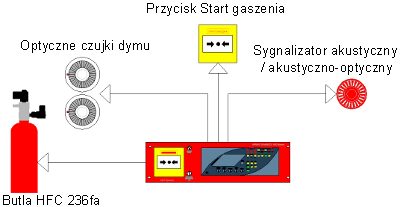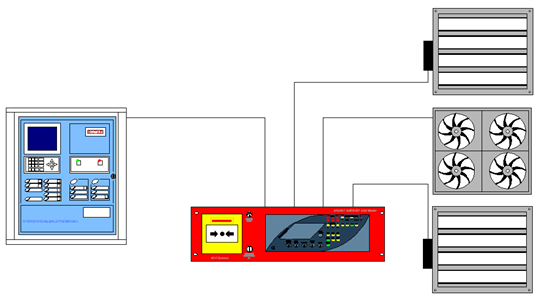AGC Master and AGC Slave Extinguishing Apparatuses
Structure of the Extinguishing Apparatus
You may submit your request for proposal here.
Standard fittingAGC Master Extinguishing Apparatus consist of:
- fire Extinguishing Control Panel with 230V power supply
- cylinder with HFC 236FA (FE-36) Extinguishing Gas
- electric actuator for gas release – compatible with the control panel
- pressure drop indicator
- pressure gauge
- two optical smoke detectors
- acoustic fire indicator
- manual release button (START EXTINGUISHING)
- batteries
- transmitter
AGC Slave Extinguishing Apparatus consist of:
- cylinder with HFC 236FA (FE-36) Extinguishing Gas
- electric actuator for gas release
- pressure drop indicator
- pressure gauge
- two optical smoke detectors
Additional fitting
AGC Master Extinguishing Apparatus includes additionally:
- external START EXTINGUISHING button to be placed outside the cabinet
- external sound horn to be placed outside the cabinet
- external smoke detectors (those may be installed only by the producer)
- in extraordinary instances the cylinder with the gaseous extinguishing agent may be placed outside the casing of the AGC Master Extinguishing Apparatus or AGC Slave Extinguishing Apparatus – this procedure to be performed only by the producer of the device.

Operating conditions
- device suitable for closed spaces only
- temperature: 0...+50°C,
- humidity: <95%,
- pressure: 80...120kPa.
- active ingredients accumulation in the atmosphere – no aggressive ingredients.
Technical data
- Power supply: 230VAC +10% -15% at 50 Hz (AGC Master Extinguishing Apparatus)
- Rated current: 0,35 A
- Emergency power supply: Batteries: 2 x 12V / 2.2 Ah sealed lead acid (AGC Master Extinguishing Apparatus)
- Extinguishing gas: HFC 236FA (FE-36)
- Amount of extinguishing gas: 2 kg
- Mass: 17 kg (Extinguishing Apparatus AGC Master), 13 kg (AGC Slave Extinguishing Apparatus)
- Dimensions (height/width/depth): 135/485/492 mm
- Protection level: IP 20
- Three volt-free relay output: 1 A, 30V
- One volt-free relay output with a time-delay relay: 6 A, 230 V AC
Outputs
AGC Master Extinguishing Apparatus is fitted with four volt-free relay contacts for transmitting the information to the external systems (Fig. 2.):
- Fire alarm
- Extinguishing gas release
- Fire suppressing control panel fault
- Switching off the ventilators

The device transmits signals not only to the outside devices – extinguishing control panels, visualization systems etc. – but is compatible also with SMS/Email-based notification systems. The device may inform the user about the fire detection, fire suppression or extinguishing apparatus’ fault.

Fire detection (outside sources)
AGC Master Extinguishing Apparatus is compatible with other fire detection devices (fig.3.):
- Fire indication system – optical smoke detectors
- Aspirating smoke detector system – early smoke detection system

Extinguishing agent
The gaseous extinguishing system HFC 236fa (FE-36) is based on hexafluoropropanol illustrated by the following chemical formula CH2F-CF2-CF3. The gas is colorless and odorless, and after compression changes its state into a liquid. The compression of the agent reaches 15 bars in 20°C after adding nitrogen. The gas is not harmful for people as well as for electrical devices placed in the air-tight cabinets. When the agent is released from the cabinet into the room the safety limits of the gas concentration are not exceeded. However, toxic chemical compounds are released into the air during the fire, hence the ventilation of the room is mandatory. Moreover, after the extinguishing procedure is done, fire security check must be carried out by the authorized personnel in order to eliminate the risk of another fire breakout.

